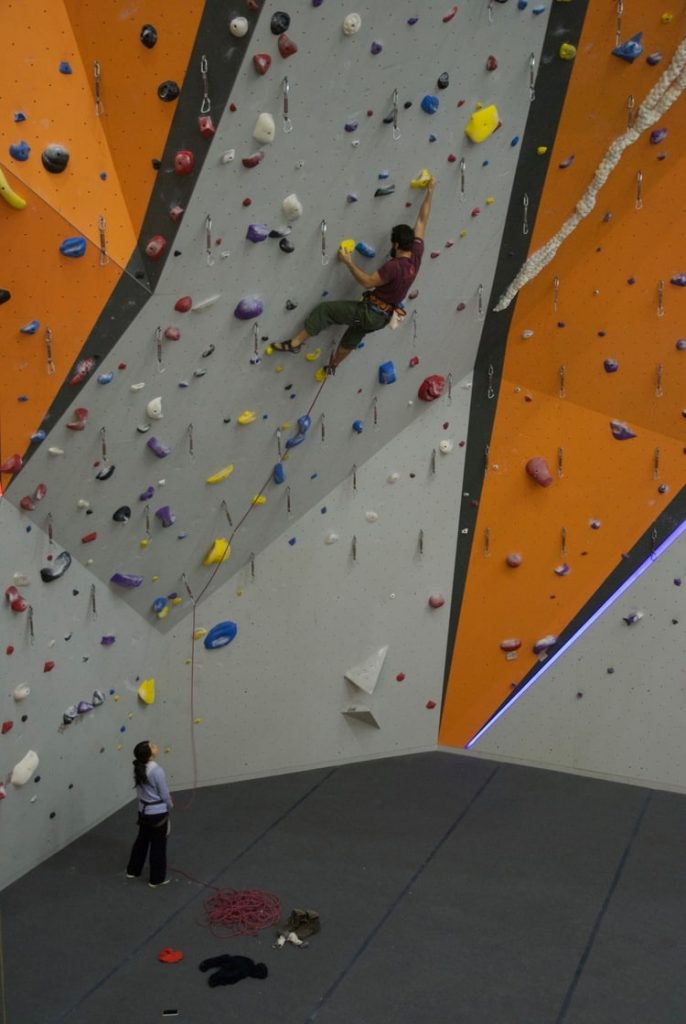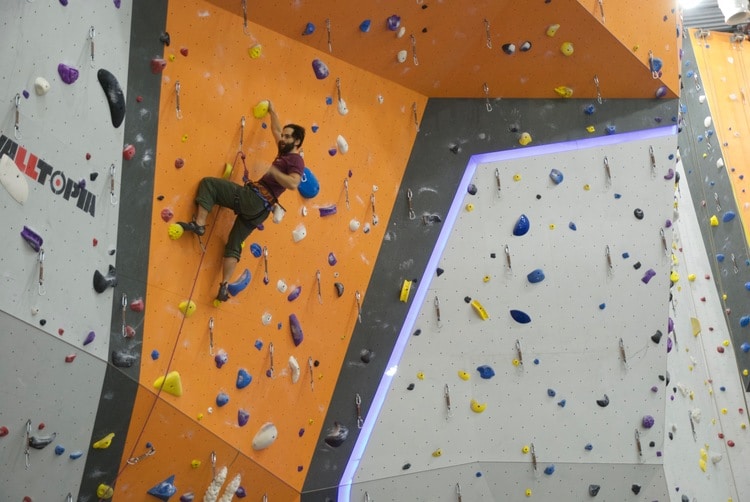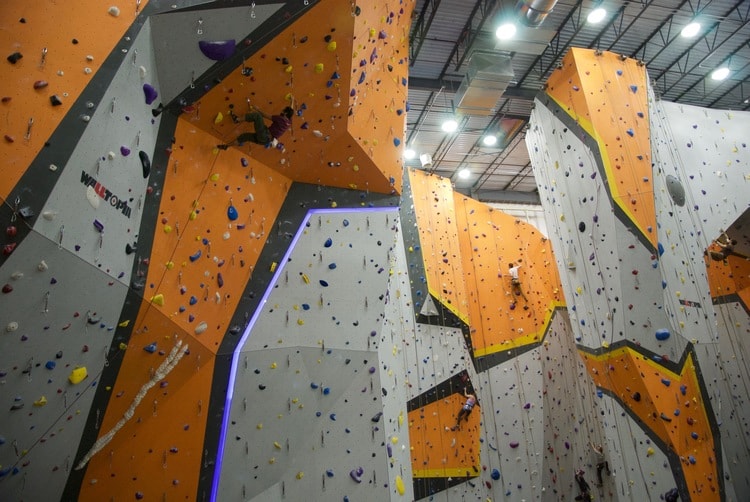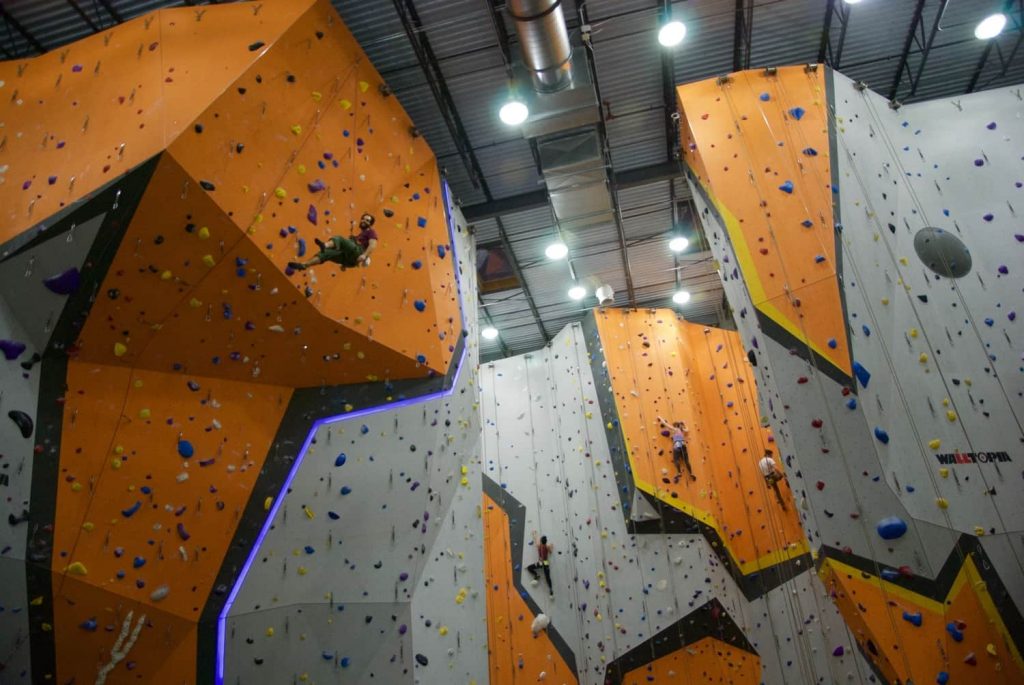For the first two months of Fall my project was the yellow 11b that took the proudest,most central line through the competition wall. On my first attempt, I clipped every draw far above myself and grew more and more pumped as I reached the roof. I felt the full force of gravity pulling me off the wall. My mind became cluttered. What if I fall? Can I trust my belayer to catch me? Is my harness on tight enough so that I won’t fall out? In a panic, I yelled “take” and my belayer tightened the rope and then gently lowered me to the ground.
Come November my fear and doubt ebbed. I wanted to send this route. Every burn, every attempt gave me new experience from which to draw confidence. Where at first my hands trembled while tying in, on later attempts I learned to calm them by focusing my breath. I made clips mostly at my waist, and instead of yelling “take” mid-route, I climbed until I fell. And though I fell multiple times before climbing to the top, I believe that I conquered something greater than this route alone. As I was being lowered, I believed I conquered my fear and doubt.

On my last attempt on the route—before it was stripped earlier this month—I climbed confidently through the first twenty feet. Clipping at my waist. Breathing slowly and consistently. Chalking up at rests. Everything felt right. I came to the headwall and the climb looked different. There was an under-cling that looked impossible to use. Surely it hadnʼt been this way my last five attempts? I was convinced the hold had spun out of position. And though my body tried the move, my mind had already been defeated. I lowered, convinced that the faulty hold made the route unclimbable. When I returned with a hex wrench to fix the spinner, I realized my error. It was not the hold that had spun; it was my head.
My unconscious mind tricked me, it manufactured an excuse for failure long before mybody had given up. Iʼd often heard climbers say that a moment was “heady”, but Ialways shied away from using that word. It seemed a drastic oversimplification of thehuman psyche: a way to avoid real analysis and keep the sheen of nonchalant bravadothat accompanies many an accomplished climber. But once again on the mat, I wasconvinced something “heady” had gotten in the way.
Since then, Iʼve thought a lot about why the word is useful to climbers. A “heady route”can result from the route itself: bolt spacing, exposure, or an outdoor climb on traditional gear that maybe youʼre not sure about as it relates to placement of protection or where the rope is crossing. But a route can also become “heady” from what the mind contributes. The “head” contains warrens of memory and personality and behavior all messily interwoven. If you reduce this complex, you get something like Alex Honhold playing psychiatrist to grief-stricken patient.
“My wife just died in an accident,” the patient says, “and the court took away mychildren, because—with my paralysis—I can no longer take care of them.”
“Woh, heady,” Doctor Honhold replies.
But of course, thereʼs a usefulness to the term. Climbers use it because it sets up a binary. Under this framework, failure on a route is either due to 1. body OR 2. head.Where I will dwell on the myriad aspects of a climb that inspire fear and doubt, a more experienced climber will just distill the feelings into “heady.”

Joe, one of the owners of First Ascent, ascribes to this binary way of looking at climbs. On a route he will 1. make it to the top OR 2. fall. And while this attitude seems like a no brainer, it’s a very difficult attitude to put into practice (remember all the head games I played with myself on the yellow 11b). Where I have to decide whether or not I can push through or should I ask my belayer for a take, Joe just climbs until he falls. In this wayJoe can focus in a way that I cannot—yet. While his mind is completely attentive to the movement, mine is dealing with that and much more.
And it should be dealing with a lot, because that is what living in contemporary society has trained my mind to do. For most mental tasks: strive to appreciate subtleties, understand contexts, and make connections. This is why Dr. Honhold failed as a psychologist. He didnʼt probe his client, reference past visits or explain prior expertise.
Honnold could only take his client’s words on the most surface level. Instead of offering insight into his patientʼs trauma he could only recite the platitude “thatʼs heady man.”

When I read a book or an article, my mind is working to apply that writing to my own life. The words on the page trigger my thoughts, memories and ideas, tangents which are integral to the experience of reading. Going quickly and efficiently from word to word is only the goal of the most elementary readers. Because the object of reading is rarely to just to memorize and recite what is being read. The object of reading is understanding.
But the ultimate goal of climbing a route is more like memorizing and reciting. Climbers must figure out the moves and perform them quickly and efficiently. For the sake of this efficiency, climbers must subdue their mind, reign in divergent thought and focus strictly on the movement which gets them from one hold to the next.
Of course, analysis is helpful once youʼre on the ground. In the time that has passedsince I hallucinated that spinner, Iʼve done some fruitful digging. Down in the annals ofmy mind, I realized that I had a lot riding on that route. Iʼd been training harder than Ihad ever trained before, and I wanted something to show for it. But my mind was notready. I hadnʼt led enough routes. I hadnʼt taken enough falls. So instead of pushingmyself to my physical limit, I pushed myself to my psychological one. A psychological limit, which was embarrassingly low.
The setters took down the old yellow 11b in late November and then there was an 11a that didn’t speak to me. A week ago, the route was changed once again. I think it’ll “go.” On my next burn, Iʼm hopeful that my reflection on the ground, and work on the wall has lightened my head.

All image credit: Dan Bartz
